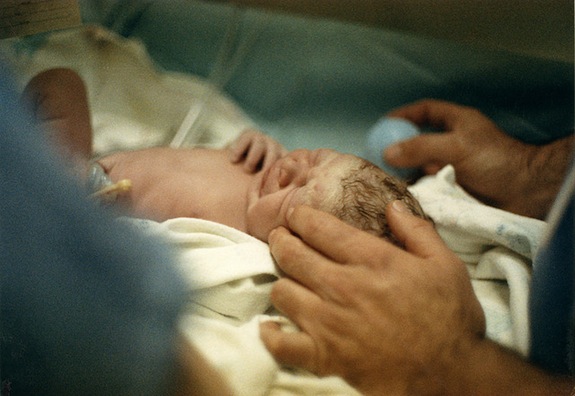Should Doctors Wait a Little Longer to Cut Umbilical Cords?
The cutting of the umbilical cord is the only surgery that every human alive has gone through. But when is the right time to cut that cord?

Image: jbhalper
The cutting of the umbilical cord is the only surgery that every human alive has gone through. We’ve all got that weird little scar on our stomachs that mark the spot where we were once connected to our mothers. But when is the right time to cut that cord?
At The Conversation, Hannah Dahlen, a Professor of Midwifery, discusses the search for the umbilical-slicing sweet spot. She writes that for a long time doctors waited until the umbilical cord stopped pulsing before cutting it—the idea was that the blood in the cord belongs in the baby and not on the floor. This is certainly true, as cutting the cord immediately after the baby is born steals from them between 80 and 100 milliliters of blood. But since the 1800s, things have changed, Dahlen writes:
However, as intervention in birth climbed in the 1950s and 60s, concerns about the amount of pain-relieving drugs and anaesthetic reaching the baby from the mother’s blood increasingly led to immediate clamping and cutting of the cord.
Today, the standard practice is to clamp and cut immediately after birth. And, unlike most things, the doctors from the 1800s might have been right on this one. Dahlen points to a study from 2011 that found that babies whose doctors waited to cut the cord had lower rates of anemia in the days after birth. Four months later, those same infants had lower rates of iron deficiency. Another review study suggests that waiting a few minutes after birth to cut the cord came with a suit of benefits like improvements cutting the risk of anemia in half. It’s not all good, though: the same study found an increased risk of jaundice and respiratory disease.
The Cochrane Library recently published a review looking at 15 different trials on cord clamping. They found that for the mother, there seemed to be no difference between cutting immediately and waiting a few minutes. But for infants, they found that the benefits of waiting to clamp and cut seemed to outweigh the risks:
A more liberal approach to delaying clamping of the umbilical cord in healthy term infants appears to be warranted, particularly in light of growing evidence that delayed cord clamping increases early haemoglobin concentrations and iron stores in infants. Delayed cord clamping is likely to be beneficial as long as access to treatment for jaundice requiring phototherapy is available.
This is in line with the recommendations of the World Health Organizaion, The Royal College of Midwives and the Royal College of Obstetricians and Gynaecologists. The American Congress of Obstetricians and Gynecologists says there isn’t enough data to make a recommendation. The National Institute for Health and Clinical Excellence in the United Kingdom still recommends early clamping. Dahlen is convinced, however, and she calls for Australia’s doctors to delay umbilical cord cutting, writing that “it may have taken us more than 50 years to begin to listen to 200-year-old advice but let’s hope we change this practice more quickly and avoid potential harm to newborn babies.”
More from Smithsonian.com:
Easy-Peasy Test Finds Serious Fetal Health Issues Earlier
Family of Man’s Special Delivery
/https://tf-cmsv2-smithsonianmag-media.s3.amazonaws.com/accounts/headshot/Rose-Eveleth-240.jpg)
/https://tf-cmsv2-smithsonianmag-media.s3.amazonaws.com/accounts/headshot/Rose-Eveleth-240.jpg)